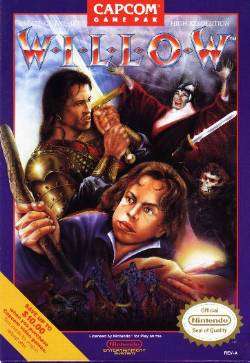Willow (NES)
| Willow | |
|---|---|
 NES cover art | |
| Developer(s) | Capcom |
| Publisher(s) | Capcom |
| Producer(s) | Tokuro Fujiwara |
| Designer(s) | Akira Kitamura |
| Composer(s) | Harumi Fujita |
| Platform(s) | Nintendo Entertainment System |
| Release | July 18, 1989 |
| Genre(s) | Action role-playing |
| Mode(s) | Single-player |
Willow is a 1989 2D action role-playing game developed and published by Capcom for the Nintendo Entertainment System. It is based on the 1988 film of the same name and loosely follows its plot. The gameplay follows the formula established by The Legend of Zelda.[1][2] Capcom previously had released an unrelated an arcade game based on Willow.
Gameplay
The player takes the role of Willow, who travels alone, wielding swords, shields, magic spells, and items to defeat enemies. The game contains some role-playing elements as Willow will gain experience and level up as he defeats enemies.[3][4][5] Rather than battery saving, it uses a password system to save the game.[6]
Development
Capcom director Yoshiki Okamoto commented that the game was part of a broader strategy of Capcom at the time to appeal to a wider audience by using established characters from other media, as their original characters could be too niche. He cited games based on Area 88 and Destiny of an Emperor as part of this strategy.[7]
In a 2014 interview with Famitsu, Shinji Mikami noted that when he joined Capcom in 1990, all of those who were accepted into the company got a free copy of the game.[8]
Reception
Famitsu magazine gave it a score of 26 out of 40.[9] Family Computer Magazine gave it a score of 21.05/30.[10] Brazilian game magazine VideoGame gave it a score of 4 out of 5.[11] Howard H. Wen, writing in Video Games and Computer Entertainment magazine gave it a score of 7 out of 10, praising the graphics, but was critical of the music and the complex password system which required 18 characters in both upper and lower case.[6]
IGN named it as the 89th best game for the NES.[1] The final issue of Nintendo Power, which was released in December 2012, Willow was ranked 254 out of 285 for best games ever to appear on Nintendo consoles.[12]
References
- 1 2 "Top 100 NES Games - IGN.com". IGN. Retrieved 2017-07-20.
- ↑ "I Can't Believe It's Not Zelda!". Destructoid. Retrieved 2017-07-20.
- ↑ "Nintendo Power". Nintendo Power. 8: 61. September-October, 1989. Check date values in:
|date=(help) - ↑ "Nintendo Power". Nintendo Power. Volume 10: 24–29. January-February, 1990. Check date values in:
|date=(help) - ↑ "Nintendo Power". Nintendo Power. 9: 8–13. November-December, 1989. Check date values in:
|date=(help) - 1 2 Video Games and Computer Entertainment: Video Games and Computer Entertainment. May 1990, page 30-31.
- ↑ "shmuplations.com". shmuplations.com. Retrieved 2017-07-20.
- ↑ Nakamura, Toshi. "Resident Evil's Creator Got a Copy of Willow For Joining Capcom". Kotaku. Retrieved 2017-07-20.
- ↑ "ウィロー [ファミコン] / ファミ通.com". www.famitsu.com. Retrieved 2017-07-20.
- ↑ "5月10日号特別付録 ファミコンロムカセット オールカタログ (Famicom Cassette All Catalog)". Family Computer Magazine. Tokuma Shoten. 7 (9): 151. 1991-05-10.
- ↑ VideoGame: VideoGame. March 1991, page 28.
- ↑ Nintendo Power. Nintendo Power. December 2012, page 12.